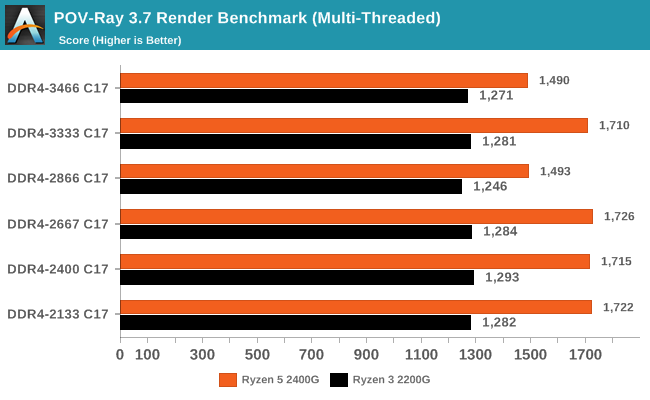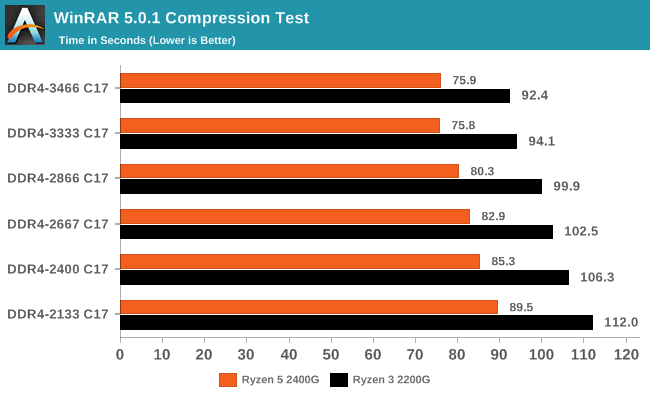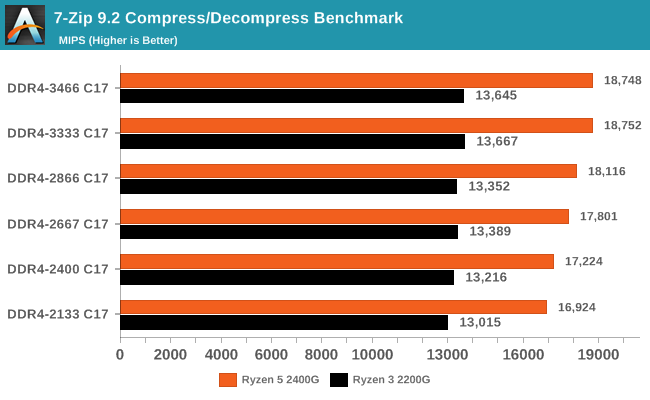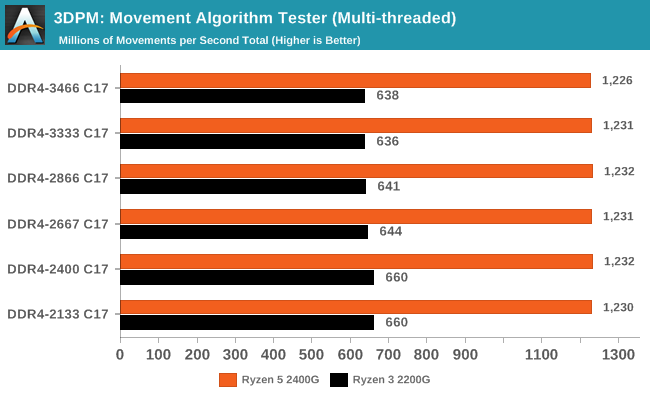Zen and Vega DDR4 Memory Scaling on AMD's APUs
by Gavin Bonshor on June 28, 2018 9:00 AM EST- Posted in
- CPUs
- Memory
- G.Skill
- AMD
- DDR4
- DRAM
- APU
- Ryzen
- Raven Ridge
- Scaling
- Ryzen 3 2200G
- Ryzen 5 2400G
CPU Performance
Rendering - Blender 2.78: link
For a render that has been around for what seems like ages, Blender is still a highly popular tool. We managed to wrap up a standard workload into the February 5 nightly build of Blender and measure the time it takes to render the first frame of the scene. Being one of the bigger open source tools out there, it means both AMD and Intel work actively to help improve the codebase, for better or for worse on their own/each other's microarchitecture.

While memory speed does influence our final rendering duration consistently by shaving seconds off, the jump from DDR4-2133 to DDR4-3333 equates to a 2% reduction overall on the Ryzen 3 2200G, although the last step from 3333 to 3466 is actually a regression. The Ryzen 5 2400G experienced a reduction of just under 4%.
Rendering – POV-Ray 3.7: link
The Persistence of Vision Ray Tracer, or POV-Ray, is a freeware package for as the name suggests, ray tracing. It is a pure renderer, rather than modeling software, but the latest beta version contains a handy benchmark for stressing all processing threads on a platform. We have been using this test in motherboard reviews to test memory stability at various CPU speeds to good effect – if it passes the test, the IMC in the CPU is stable for a given CPU speed. As a CPU test, it runs for approximately 1-2 minutes on high-end platforms.

Our results in POV-Ray 3.7 were a little hit and miss and showed irregularities at different memory clock speeds, perhaps due to the additional power required by the memory controller at higher frequencies taking away from available CPU power. This means POV-Ray isn’t really influenced more by the memory speeds themselves, although it is certainly more determined from more CPU cores and higher frequencies as the difference between the 2200G and 2400G show.
WinRAR 5.4: link
Our WinRAR test from 2013 is updated to the latest version of WinRAR at the start of 2014. We compress a set of 2867 files across 320 folders totaling 1.52 GB in size – 95% of these files are small typical website files, and the rest (90% of the size) are small 30-second 720p videos.

As the memory frequency was increased, the compression time was consistently lower going up a memory strap. With WinRAR being one of our most DRAM-affected CPU tests, we have seen this before with other CPU generations. The 2200G saw a 21% increase in throughput, while the 2400G had a +18% gain. However it is worth noting that the DDR4-3466 time was slightly slower than that of the DDR4-3333 time again.
7-Zip 9.2: link
As an open source compression tool, 7-Zip is a popular tool for making sets of files easier to handle and transfer. The software offers up its own benchmark, to which we report the result.

The 7-Zip results are interesting as with both Ryzen based APUs at the DDR4-3333 setting saw the biggest benefit in compression and decompressing. Again, the top strap in our testing was not the most performant. Overall gains were +11% for the 2400G, and +5% for the 2200G, in line with thread counts.
Point Calculations – 3D Movement Algorithm Test: link
3DPM is a self-penned benchmark, taking basic 3D movement algorithms used in Brownian Motion simulations and testing them for speed. High floating point performance, MHz, and IPC win in the single thread version, whereas the multithread version has to handle the threads and loves more cores. For a brief explanation of the platform agnostic coding behind this benchmark, see my forum post here.

With our 3DPM Brownian Motion simulator benchmark, memory frequency made little difference in increasing performance, although as our results show, the slower the memory, the better performance we experienced on the Ryzen 3 2200G. The Ryzen 2400G experienced a similar range of inconsistent and inconsequential results showing little to no improvement as the memory strap was increased.
Neuron Simulation - DigiCortex v1.20: link
The newest benchmark in our suite is DigiCortex, a simulation of biologically plausible neural network circuits, and simulates activity of neurons and synapses. DigiCortex relies heavily on a mix of DRAM speed and computational throughput, indicating that systems which apply memory profiles properly should benefit and those that play fast and loose with overclocking settings might get some extra speed up. Results are taken during the steady state period in a 32k neuron simulation and represented as a function of the ability to simulate in real time (1.000x equals real-time).

DigiCortex experienced a very subsequent increase throughout the tested memory straps on both the Ryzen APUs, with a nice jump in performance of 22% on the 2200G and on the 2400G.










74 Comments
View All Comments
gavbon - Monday, July 2, 2018 - link
I really appreciate it, I have said all along that iGPU is coming, I'm working on it now currently and I'm currently looking at which variables to consider during the testing. As for memory, capacity doesn't have any bearing on performance other than in situations where memory is running at maximum capacity.Soon as I work out the tests I'm going to run, I can crack on! :D
hansmuff - Thursday, June 28, 2018 - link
Please someone tell me how to get that particular recommended G.Skill set to work at 2933 on a 2400G CPU. I haven't been able to get it past 2100 with Prime95 stability. What am I doing wrong?Gigabyte AB350N motherboard latest BIOS
Thanks
DennisSmith - Thursday, July 5, 2018 - link
Hi hansmuff, I just had a similar problem with a 2400G and ASRock AB350M build. Reading the MB manual, I noticed they recommend when installing only 2 sticks to use DIMM slots 2 & 4 rather than 1 & 3. After making that change, I reached the rated 3200 speed after enabling XMP in the UEFI / BIOS, and I am stable at 3400 now using the Master Ryzen Software to set the frequency (3400 is not an option in the UEFI menu).Lolimaster - Friday, June 29, 2018 - link
Again doing review the wrong way, 3466 with too high latencies and for the sake of being "consistent" all the slower dram setting are getting injured by the "global" latency for the sake of being consistent.Just do a CL15 across all kits.
Vatharian - Friday, June 29, 2018 - link
To some degree he is right - Jedec has in specification, that modules regardless of speed must support 2133 or more recently 2666 MHz. Faster modules accelerate only by manually inputing over 40 parameters or loading them up from XMP profiles. And as a matter of fact I have only seen two modules that support 'base' speed of 2666 instead of 2133 MHz.Truth is, XMP is a stop-gap, JEDEC should have prepared something universal that will do XMP's job, otherwise only thing that's left is memory ladder like ramp-up that is not fault proof, and good luck on eight module four channels that work on 4200+ MHz, you'll get boot times in range of five minutes.
plonk420 - Saturday, June 30, 2018 - link
i hope this doesn't get buried, but could you do some tests that use the CPU on just 1 stick of RAM? i built a distributed computing box and as my budget wouldn't allow at the time, just got 1 4GB stick of DDR4-2400. and i'm still only at ~66-75% memory use with some of World Community Grid's more memory intensive programs PLUS 3 instances of MilkyWay@Home on the GPUGreenReaper - Saturday, June 30, 2018 - link
If you don't want to get buried, don't call yourself plonk - it's the sound a user makes when they're added to a Usenet killfile!peevee - Tuesday, July 3, 2018 - link
"just got 1 4GB stick of DDR4-2400. "Why even bother to build such a joke?
SanX - Sunday, July 1, 2018 - link
On a different note with memory speed not related to higher frequency per single channel. There existed dual channel, quad channel, even eight channel memory architectures. Can anyone show the applications which benefit from this the most? For example are Gauss elimination matrix equation solvers or particle movement or PIC methods or even some games actually memory bandwidth bound? If yes do we get 2x, 4x or 8x increases in performances with such architectures? That where people may actually say WOW.Ian?
Cloakstar - Monday, July 2, 2018 - link
This is not a full memory scaling test. Where is the testing for scaling out to 4 sticks of RAM and bank/channel interleaving? I have found this to be critical to getting the most FPS out of prior generation AMD APU's.